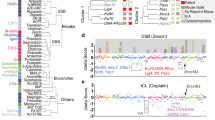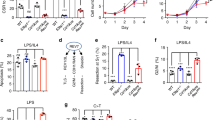Abstract
The ability of activation-induced cytidine deaminase (AID) to efficiently mediate class-switch recombination (CSR) is dependent on its phosphorylation at Ser38; however, the trigger that induces AID phosphorylation and the mechanism by which phosphorylated AID drives CSR have not been elucidated. Here we found that phosphorylation of AID at Ser38 was induced by DNA breaks. Conversely, in the absence of AID phosphorylation, DNA breaks were not efficiently generated at switch (S) regions in the immunoglobulin heavy-chain locus (Igh), consistent with a failure of AID to interact with the endonuclease APE1. Additionally, deficiency in the DNA-damage sensor ATM impaired the phosphorylation of AID at Ser38 and the interaction of AID with APE1. Our results identify a positive feedback loop for the amplification of DNA breaks at S regions through the phosphorylation- and ATM-dependent interaction of AID with APE1.
This is a preview of subscription content, access via your institution
Access options
Subscribe to this journal
Receive 12 print issues and online access
$209.00 per year
only $17.42 per issue
Buy this article
- Purchase on Springer Link
- Instant access to full article PDF
Prices may be subject to local taxes which are calculated during checkout






Similar content being viewed by others
References
Stavnezer, J., Guikema, J.E. & Schrader, C.E. Mechanism and regulation of class switch recombination. Annu. Rev. Immunol. 26, 261–292 (2008).
Muramatsu, M. et al. Class switch recombination and hypermutation require activation-induced cytidine deaminase (AID), a potential RNA editing enzyme. Cell 102, 553–563 (2000).
Revy, P. et al. Activation-induced cytidine deaminase (AID) deficiency causes the autosomal recessive form of the Hyper-IgM syndrome (HIGM2). Cell 102, 565–575 (2000).
Petersen-Mahrt, S.K., Harris, R.S. & Neuberger, M.S. AID mutates E. coli suggesting a DNA deamination mechanism for antibody diversification. Nature 418, 99–103 (2002).
Rada, C., Di Noia, J.M. & Neuberger, M.S. Mismatch recognition and uracil excision provide complementary paths to both Ig switching and the A/T-focused phase of somatic mutation. Mol. Cell 16, 163–171 (2004).
Guikema, J.E. et al. APE1- and APE2-dependent DNA breaks in immunoglobulin class switch recombination. J. Exp. Med. 204, 3017–3026 (2007).
Masani, S., Han, L. & Yu, K. Apurinic/apyrimidinic endonuclease 1 is the essential nuclease during immunoglobulin class switch recombination. Mol. Cell. Biol. 33, 1468–1473 (2013).
Iwasato, T., Arakawa, H., Shimizu, A., Honjo, T. & Yamagishi, H. Biased distribution of recombination sites within S regions upon immunoglobulin class switch recombination induced by transforming growth factor β and lipopolysaccharide. J. Exp. Med. 175, 1539–1546 (1992).
Matsuoka, M., Yoshida, K., Maeda, T., Usuda, S. & Sakano, H. Switch circular DNA formed in cytokine-treated mouse splenocytes: evidence for intramolecular DNA deletion in immunoglobulin class switching. Cell 62, 135–142 (1990).
Petersen, S. et al. AID is required to initiate Nbs1/γ-H2AX focus formation and mutations at sites of class switching. Nature 414, 660–665 (2001).
Wuerffel, R.A., Du, J., Thompson, R.J. & Kenter, A.L. Ig Sγ3 DNA-specifc double strand breaks are induced in mitogen-activated B cells and are implicated in switch recombination. J. Immunol. 159, 4139–4144 (1997).
Papavasiliou, F.N. & Schatz, D.G. Somatic hypermutation of immunoglobulin genes: merging mechanisms for genetic diversity. Cell 109, S35–S44 (2002).
Daniel, J.A. & Nussenzweig, A. The AID-induced DNA damage response in chromatin. Mol. Cell 50, 309–321 (2013).
Vuong, B.Q. & Chaudhuri, J. Combinatorial mechanisms regulating AID-dependent DNA deamination: Interacting proteins and post-translational modifications. Semin. Immunol. 24, 264–272 (2012).
Cheng, H.L. et al. Integrity of the AID serine-38 phosphorylation site is critical for class switch recombination and somatic hypermutation in mice. Proc. Natl. Acad. Sci. USA 106, 2717–2722 (2009).
McBride, K.M. et al. Regulation of class switch recombination and somatic mutation by AID phosphorylation. J. Exp. Med. 205, 2585–2594 (2008).
Basu, U. et al. The AID antibody diversification enzyme is regulated by protein kinase A phosphorylation. Nature 438, 508–511 (2005).
Pasqualucci, L., Kitaura, Y., Gu, H. & Dalla-Favera, R. PKA-mediated phosphorylation regulates the function of activation-induced deaminase (AID) in B cells. Proc. Natl. Acad. Sci. USA 103, 395–400 (2006).
Vuong, B.Q. et al. Specific recruitment of protein kinase A to the immunoglobulin locus regulates class-switch recombination. Nat. Immunol. 10, 420–426 (2009).
Chaudhuri, J., Khuong, C. & Alt, F.W. Replication protein A interacts with AID to promote deamination of somatic hypermutation targets. Nature 430, 992–998 (2004).
Yamane, A. et al. Deep-sequencing identification of the genomic targets of the cytidine deaminase AID and its cofactor RPA in B lymphocytes. Nat. Immunol. 12, 62–69 (2011).
Yamane, A. et al. RPA accumulation during class switch recombination represents 5′-3′ DNA-end resection during the S-G2/M phase of the cell cycle. Cell Rep. 3, 138–147 (2013).
Wold, M.S. Replication protein A: a heterotrimeric, single-stranded DNA-binding protein required for eukaryotic DNA metabolism. Annu. Rev. Biochem. 66, 61–92 (1997).
Chaudhuri, J. et al. Transcription-targeted DNA deamination by the AID antibody diversification enzyme. Nature 422, 726–730 (2003).
Papavasiliou, F.N. & Schatz, D.G. The activation-induced deaminase functions in a postcleavage step of the somatic hypermutation process. J. Exp. Med. 195, 1193–1198 (2002).
Schrader, C.E., Guikema, J.E., Linehan, E.K., Selsing, E. & Stavnezer, J. Activation-induced cytidine deaminase-dependent DNA breaks in class switch recombination occur during G1 phase of the cell cycle and depend upon mismatch repair. J. Immunol. 179, 6064–6071 (2007).
Schrader, C.E., Linehan, E.K., Mochegova, S.N., Woodland, R.T. & Stavnezer, J. Inducible DNA breaks in Ig S regions are dependent on AID and UNG. J. Exp. Med. 202, 561–568 (2005).
Maul, R.W. et al. Uracil residues dependent on the deaminase AID in immunoglobulin gene variable and switch regions. Nat. Immunol. 12, 70–76 (2011).
Imai, K. et al. Human uracil-DNA glycosylase deficiency associated with profoundly impaired immunoglobulin class-switch recombination. Nat. Immunol. 4, 1023–1028 (2003).
Xanthoudakis, S., Smeyne, R.J., Wallace, J.D. & Curran, T. The redox/DNA repair protein, Ref-1, is essential for early embryonic development in mice. Proc. Natl. Acad. Sci. USA 93, 8919–8923 (1996).
Schrader, C.E., Guikema, J.E., Wu, X. & Stavnezer, J. The roles of APE1, APE2, DNA polymerase beta and mismatch repair in creating S region DNA breaks during antibody class switch. Phil. Trans. R. Soc. Lond. B 364, 645–652 (2009).
Rush, J.S., Fugmann, S.D. & Schatz, D.G. Staggered AID-dependent DNA double strand breaks are the predominant DNA lesions targeted to Sm in immunoglobulin class switch recombination. Int. Immunol. 16, 549–557 (2004).
Hasham, M.G. et al. Activation-induced cytidine deaminase-initiated off-target DNA breaks are detected and resolved during S phase. J. Immunol. 189, 2374–2382 (2012).
Lee, J.H. & Paull, T.T. Activation and regulation of ATM kinase activity in response to DNA double-strand breaks. Oncogene 26, 7741–7748 (2007).
Lumsden, J.M. et al. Immunoglobulin class switch recombination is impaired in Atm-deficient mice. J. Exp. Med. 200, 1111–1121 (2004).
Reina-San-Martin, B., Chen, H.T., Nussenzweig, A. & Nussenzweig, M.C. ATM is required for efficient recombination between immunoglobulin switch regions. J. Exp. Med. 200, 1103–1110 (2004).
Liu, M. et al. Two levels of protection for the B cell genome during somatic hypermutation. Nature 451, 841–845 (2008).
Ranjit, S. et al. AID binds cooperatively with UNG and Msh2-Msh6 to Ig switch regions dependent upon the AID C terminus. J. Immunol. 187, 2464–2475 (2011).
Bensimon, A., Aebersold, R. & Shiloh, Y. Beyond ATM: the protein kinase landscape of the DNA damage response. FEBS Lett. 585, 1625–1639 (2011).
Searle, J.S., Schollaert, K.L., Wilkins, B.J. & Sanchez, Y. The DNA damage checkpoint and PKA pathways converge on APC substrates and Cdc20 to regulate mitotic progression. Nat. Cell Biol. 6, 138–145 (2004).
Liu, Y. et al. Interactions of human mismatch repair proteins MutSα and MutLα with proteins of the ATR-Chk1 pathway. J. Biol. Chem. 285, 5974–5982 (2010).
Franco, S. et al. H2AX prevents DNA breaks from progressing to chromosome breaks and translocations. Mol. Cell 21, 201–214 (2006).
Barlow, C. et al. Atm-deficient mice: a paradigm of ataxia telangiectasia. Cell 86, 159–171 (1996).
Guikema, J.E. et al. p53 represses class switch recombination to IgG2a through its antioxidant function. J. Immunol. 184, 6177–6187 (2010).
Erzberger, J.P., Barsky, D., Scharer, O.D., Colvin, M.E. & Wilson, D.M. 3rd Elements in abasic site recognition by the major human and Escherichia coli apurinic/apyrimidinic endonucleases. Nucleic Acids Res. 26, 2771–2778 (1998).
Ishiai, M., Sanchez, J.P., Amin, A.A., Murakami, Y. & Hurwitz, J. Purification, gene cloning, and reconstitution of the heterotrimeric single-stranded DNA-binding protein from Schizosaccharomyces pombe. J. Biol. Chem. 271, 20868–20878 (1996).
Acknowledgements
We thank J. Hurwitz (Memorial Sloan-Kettering Cancer Center) for recombinant human RPA; members of the Chaudhuri laboratory, D. Sant' Angelo and L. Denzin for critically reviewing the manuscript and for discussions and suggestions; V. Bermudez and J. Hurwitz for help in purifying recombinant human RPA; J. Lange and S. Keeney (Memorial Sloan-Kettering Cancer Center) for Atm−/− mice; and D.M. Wilson III (US National Institutes of Health) for the plasmid for expression of human APE1. Supported by the US National Institutes of Health (RO1AI23283 and R21 AI099908 to J.S., 5 R01 CA138646-04 to K.D.M. and 1RO1AI072194 to J.C.) and the Starr Cancer Consortium (I4-A447 to J.C.).
Author information
Authors and Affiliations
Contributions
B.Q.V. and J.C. conceived of the study and wrote the paper; B.Q.V., K.H.-R., B.V., J.N.P. and U.N. did the ChIP experiments; B.Q.V., K.H.-R. and B.V. did the coimmunoprecipitation and in vitro binding experiments; A.J.U. and J.S. did the LM-PCR experiment and bred the Apex1+/−Apex2−/− mice; N.M.D. and K.D.M. did the immuno-FISH; X.G. and M.P.S. bred the Ung−/−Msh2−/− mice; and N.R., B.Q.V., K.H.-R. and L.N. bred and analyzed the Aicda−/−, Atm−/− and AicdaS38A/S38A mice.
Corresponding authors
Ethics declarations
Competing interests
The authors declare no competing financial interests.
Supplementary information
Supplementary Text and Figures
Supplementary Figures 1–10 (PDF 905 kb)
Rights and permissions
About this article
Cite this article
Vuong, B., Herrick-Reynolds, K., Vaidyanathan, B. et al. A DNA break– and phosphorylation-dependent positive feedback loop promotes immunoglobulin class-switch recombination. Nat Immunol 14, 1183–1189 (2013). https://doi.org/10.1038/ni.2732
Received:
Accepted:
Published:
Issue Date:
DOI: https://doi.org/10.1038/ni.2732
This article is cited by
-
At the intersection of DNA damage and immune responses
Nature Reviews Immunology (2019)
-
Deficient humoral responses and disrupted B-cell immunity are associated with fatal SFTSV infection
Nature Communications (2018)
-
You break it, you fix it: functions for AID downstream of deamination
Nature Immunology (2013)



